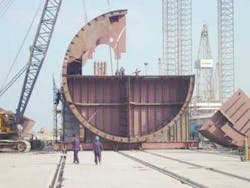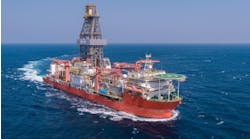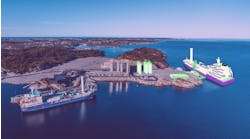Sweden: SEMISUBMERSIBLE TRENDS: GVA-designed Khazar will be Caspian'sfirst true deepwater drilling unit
Judy Maksoud
International Editor
A new semisubmersible rig under construction in an Iranian yard is being built for exclusive use in the Caspian Sea. Though the semi is being constructed in Iran, GVA Consultants (GVA-C), the company that provided the design, is Swedish. According to Robert Ludwigson, vice president of business development at GVA-C, the new semisubmersible will be the first designed by GVA for the Caspian and the first to be built in Iran.
GVA-C has a history that spans more than two decades. Beginning life as a shipyard, GVA-C is now a marine and offshore engineering firm and, since about 18 months ago, a design subsidiary of KBR. The company specializes in consultancy, engineering design, and project management related to semisubmersibles. GVA-C provides construction management, site supervision, and engineering services to oil companies, drilling contractors, ship owners, and shipyards worldwide.
Past, present, and future
According to Ludwigson, five out of nine purpose-built floating production semisubmersibles worldwide are of GVA design. They include the Balmoral, Petrobras XVIII, Visund, Troll C, and Åsgard B.
GVA-C has also designed a number of semisubmersible drilling units, including the Transocean Winner, Transocean Rather, Trans-ocean Richardson, Sovereign Explorer, and Petrobras 23. GVA-C has been involved with three significant semi production units in the last few years. Currently, GVA-C is engaged in three major development projects: the Thunder Horse and Atlantis semis in the Gulf of Mexico, and the Kristin production semisubmersible in the North Sea.
Column stringer plan being lifted in place in the Neka yard.
null
GVA semisubmersibles are working in the North Sea, off Brazil, and in the Gulf of Mexico. When the company's newest design is put into service, the Caspian Sea will be added to the list of regions where GVA designs are in use.
GVA-C's newest initiative is the design of the Khazar, a semi being built exclusively for use in the Caspian. Khazar, which means Caspian Sea in Farsi, is being built in cooperation with Sadra, an Iranian shipyard.
Cooperative effort
The Khazar semisubmersible drilling unit project is the result of a National Iranian Oil Co. initiative to increase Iran's exploration capability in the Caspian Sea. The objectives are to provide deepwater capability and to prove possible reserves. The Iranian sector of the Caspian is underexplored, and there are large undeveloped oil and gas reserves beneath the surface. The Energy Information Administration, a segment of the US Department of Energy, places proven reserves in the Caspian Sea at 177-182 tcf of gas and 16.9-33.4 Bbbl. Possible reserves estimates are as high as 293 tcf and 233 Bbbl.
Four-fifths of the northern Caspian Sea is less than 10 m deep, with an average depth of 6.2 m in this portion of the sea. The deepest part of the Caspian is in the south, where the average depth is 334 m, with some segments of the seabed at depths as great as 1,000 m. The deepest parts of the sea are in the Iranian offshore. For this reason, the Khazar is designed to operate in moored depths to 3,500 ft.
To date, there are only two other semisubmersibles working in the Caspian Sea – the Dada Gorgud, with a water depth rating of 457 m, and the Istiglal, rated at 475-m capability.
GVA-C is working on the Khazar project in conjunction with Sadra, an Iranian shipyard that is building the semi at its Neka yard in northern Iran. Sadra is Iran's largest shipyard group and is a semi-private company in which the largest shareholder is a government agency. Sadra owns the only Iranian shipyard large enough for semi construction. Though Sadra's experience prior to taking on Khazar includes only jackup construction, work on the semi is progressing well, Ludwigson said. Once this rig is built successfully, there is potential for more to follow, he said.
Semisubmersible application
While work progresses on the Caspian semi, GVA-C is looking into a number of other international arenas. Ludwigson believes semisubmersibles will be much more a part of development decisions in the Gulf of Mexico in the coming years.
"Down the road, interest for semisubmersibles will grow," he said. Part of the reason for this is the cost savings, which Ludwigson calculated at $50-$100 million cheaper than a TLP or Spar in water deeper than 4,000 ft. Recent engineering studies have shown the semi option to be $200 million cheaper than a Spar at 10,000 ft, Ludwigson said.
Interestingly, GVA-C views semis as a viable choice in shallow water as well. Nils Mårtensson, GVA-C's engineering manager for the Thunder Horse project, sees significant potential for shallow-water semis.
"Production semisubmersibles have proven to be an economical asset in water depths of 1,000 ft and less," he said.
Other things in the works
The main technical challenge for semis these days is steel catenary risers (SCRs), according to Mårtensson.
"Everything else on the semi is proven," he said. "This is the remaining challenge."
GVA-C, along with other engineering companies, is investing resources in research that will answer the SCR issues, isolating and answering concerns with motion that can stress SCRs and cause early fatigue.
GVA-C's head office is in Gothenburg, Sweden. A new office is being opened in Houston, Texas.
For information, contact Robert Ludwigson, GVA Consultants. Tel: +46 31 10 67 00, fax: +46 31 10 67 10, email: [email protected], website: www.gvaconsultants.com.




